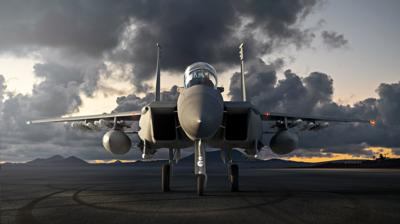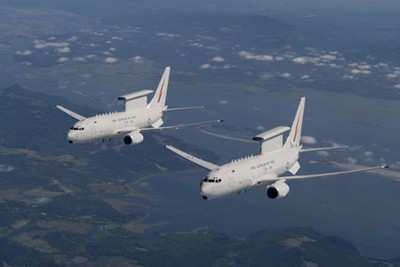Aim High
While the December 2022 rollout of its B-21 Raider stealth bomber has commanded the lion’s share of interest in and controversy over the United States Air Force’s latest aircraft acquisitions, the service—by dint of the $858-billion Congress has allocated for military spending in fiscal 2023—is making ready to take on a veritable cornucopia of new and formidable sky-going machines.

In addition to getting about the business of flight-testing its new, sixth-generation, ultra-long-range strategic bomber, the USAF is preparing to take delivery of 24 specimens of Boeing’s F-15EX Eagle II fighter.
Rolled out in 2020 and first flown in February 2021, the F-15EX invigorates the proven F-15 airframe with a digital backbone and open system architecture. Notwithstanding the eighty-to-ninety-percent commonality the F-15EX shares with the F-15C, the new jet offers enhanced survivability, superior weapons carriage, and the capacity to carry hypersonic weapons. The latter attribute derives of the curious fact that the original F-15 design is capable of exceeding Mach 3.0. Legacy F-15s, owing to their age and state of relative degeneration, are speed restricted. The F-15EX, by virtue of its youth and the 58,000-pounds of total thrust produced by its two General Electric F110-GE-129 afterburning turbofan engines, is capable of loping along at Mach 2.5—a speed that earns the fearsome beastie the title of World’s Fastest Fighter Jet.
The first operational F-15EX Eagle IIs will be stationed at Oregon’s Portland National Guard Base on Portland International Airport (PDX).

As contraptions the likes of the Eagle II are, by nature, thirsty, 2023 will see the Air Force add another 24 KC-46 Pegasus tankers to its inventory. Across the USAF’s global operations theater, the KC-46, which derives of Boeing’s 767 commercial airliner, is steadily replacing the service’s aging KC-135s and KC-10s —airborne refueling platforms respectively based on Boeing’s storied 707 and McDonnell Douglas’s lesser-storied DC-10.
Boeing’s hegemony is further evinced by the imminent delivery of five MH-139A Gray Wolf multi-mission helicopters, which will be plied to the protection of USAF nuclear missile installations in Wyoming, Montana, North Dakota, Colorado, and Nebraska. The MH-139As will also carry out the decidedly indecorous work of transporting self-important U.S. government officials at taxpayer expense. Produced in the United States through a joint venture of Boeing and Leonardo, and based on the latter’s medium-lift, twin-engine AW-139 helicopter, the MH-139A will replace the USAF’s long-in-the-tooth UH-1N Twin Huey fleet, the first example of which took flight in 1969—the selfsame year Richard M. Nixon was sworn in as the 37th President of the United States.
The Air Force’s rotary-wing fleet is to be further enhanced by the acquisition of twenty HH-60W Jolly Green II combat rescue helicopters. Evolved from the ubiquitous UH-60 Blackhawk the HH-60W will replace the Air Force’s HH-60G Pave Hawk. The machine’s jovial moniker is an homage to Sikorsky’s legendary, HH-3E Jolly Green Giant helicopters, the bright-green liveries of which remain lovingly fixed in the memories of innumerable Vietnam War combat veterans airlifted to safety of field surgeries by the mighty aircraft.
For purpose of bolstering its combat readiness, the USAF, in 2023, will also receive 38 additional F-35A Lightning II fighter jets and four EC-37B Compass Call electronic attack aircraft.
Based on Gulfstream’s G550 Conformal Airborne Early Warning Aircraft (CAEW) airframe—which itself derives of the Savannah airframer’s highly-successful G550 business jet—the EC-37B is equipped with Compass Call, an airborne tactical electronic attack weapon system that disrupts enemy command and control communications, radars, and navigation systems, thereby restricting battlefield coordination. Subject technology is currently installed on Lockheed-Martin’s C-130 derivative EC-130H Compass Call electronic attack aircraft.

The EC-37Bs will supplement the USAF’s growing number of E-7 Wedgetail twin-engine Airborne Early Warning and Control (AEW&C) aircraft based on Boeing’s 737-700ER Next Generation design. Unlike the circular, ventral radar array of the 707-based Boeing E-3 Sentry AWACS (Airborne Warning and Control System) platform it’s destined to replace, the E-7 sports a fin-shaped dorsal radar antenna dubbed the top hat. Capable of simultaneous air and sea search, fighter control, and area search within a maximum range of over 323-nautical-miles, the E-7’s top hat doubles as an Electronic Intelligence (ELINT) array with a maximum range of over 458-nautical-miles at an aircraft altitude of FL300.
The coming year will also see pre-production flight-testing of Boeing’s T-7 Red Hawk training jet—the first lot of which the USAF looks to acquire in 2024.
The extent to which Congress fulfilled the U.S. Air Force’s 2023 wish-list remains unknown.
 Airborne-Flight Training 05.09.24: ERAU at AIAA, LIFT Diamond Buy, Epic A&P
Airborne-Flight Training 05.09.24: ERAU at AIAA, LIFT Diamond Buy, Epic A&P ANN's Daily Aero-Term (05.07.24): Hazardous Weather Information
ANN's Daily Aero-Term (05.07.24): Hazardous Weather Information Aero-News: Quote of the Day (05.07.24)
Aero-News: Quote of the Day (05.07.24) NTSB Final Report: Cessna 150
NTSB Final Report: Cessna 150 Aero-News: Quote of the Day (05.08.24)
Aero-News: Quote of the Day (05.08.24)





